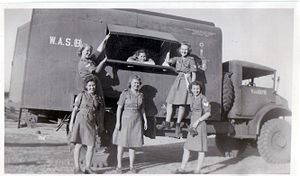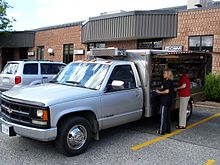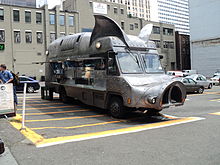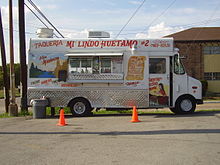- Food truck
-
 Mobile WAS(B) Canteen at Nasik.
Mobile WAS(B) Canteen at Nasik. See also: Mobile catering
See also: Mobile cateringA food truck, mobile kitchen, mobile canteen, or catering truck is a mobile venue that sells food. Some, including ice cream trucks, sell mostly frozen or prepackaged food; others are more like restaurants-on-wheels. Some may cater to specific meals, such as the breakfast truck, lunch truck or lunch wagon, and snack truck, break truck or taco truck.
Food trucks cater events (carnivals, construction sites, sporting events etc.) where potential customers gather, and places of regular work or study – college campuses, office complexes, industrial parks, auto repair shops, movie sets, military bases, etc. – where potential customers require regular meals or snacks.
Contents
Regional variants
United Kingdom
In the United Kingdom, in history, there was very little use for the food truck or wagon in civilian life, and its limited use was for the military. Its limited use is for a variety of reasons, such as the small distance between troops and populations centres, the high productivity of the land that would be familiar to the native soldiers and the lack of any large campaigning force in the British Isles. By the late 17th Century and onwards, when the United Kingdom had substantial forces of troops serving abroad, it fell upon individual military commanders to supply troops, often employing local wagon drivers to transport goods. Later, organised military logistics came under the responsibility of what is now known as the Royal Logistics Corps. Both methods of supply (organised either individually by commanders or by a dedicated corps) employed temporary field kitchens, often constructed from tents, rather than found on wagons or food trucks. The added advantage of this alternate method was the relative mobility of a temporary kitchen on mules over the heavy wooden-wheeled wagons. It wasn't until World War II and the advent of motorised transport that food trucks came into common use. Mobile canteens were used in almost all theatres of war to boost morale and provide food as a result of the successful tea lady experiment.[1]
In recent times and as a result of the lower cost of manufacturing, the food truck has been used in the commercial sector. These are known as "snack vans" and can be found on nearly all major trunk roads at the side of the road or in areas that have a large pedestrian population, such as at village fetes or town centres. These vans can specialise in a myriad of different food types, such as donuts, hamburgers, chili and chips, as well as ethnic and minority food. Some people prefer to stop at one of these burger vans when travelling, due to the low price, rather than stop at a motorway service station where prices can be extremely high.
Asia
In Asia, the cuisine offered by food trucks require simple skills, basic facilities and a relatively small amount of capital. They are plentiful, with large potential for income and often a very large sector for employment. Individuals facing difficulty finding work in formal sectors, will often venture into this industry, as it allows entire families to involve themselves in the preparing and cooking of foods sold to the public. The appeal involved in sustaining a food truck lie not only in the low capital requirement, but also in the flexibility of hours, with minimal constraints to locale. Street foods predominantly reflect local culture and flavor. Food trucks appeal to consumers in that they are often an inexpensive means of attaining quick meals. Location and word of mouth promotion has been credited for their widening success.[2]
Canada
The food truck is also found in North America. In anglophone Canada, they are known as "lunch trucks" or "coffee trucks". In francophone Canada, they are commonly known as "cantines" (French for cafeteria).
Origin of the food truck in the United States
After the American Civil War, there was a mass expansion to move westward. The expansion created a large market for beef, specifically in Texas. Innovative cattlemen needed to herd cattle to parts of the country that did not have railroads which would mean they would be on the road for months at a time.[3] The need to feed these cattlemen resulted in the creation of the chuckwagon. The origin of the chuckwagon or food truck, stems from the "father of the Texas Panhandle," Charles Goodnight.[4] In 1866, Charles, a cattle herder, realized how difficult it was to cook proper meals during cattle drives. With that, he took a sturdy old Army wagon and constructed interior shelving and drawers. He then stocked the wagon with tableware and utensils, spices and medical supplies, including castor oil and quinine. Heavy pots and pans were stashed on the lower shelves while food was kept on in the bed of the wagon. Food consisted of dried beans, coffee, cornmeal, and other easy to preserve food stuffs. There was no fresh fruit, vegetables, or eggs available and meat was not fresh unless an animal was injured during the run and therefore had to be killed. The meat they ate was greasy cloth-wrapped bacon, salt pork, and beef, usually dried or salted or smoked. The wagon was also stocked with a water barrel and a sling to kindle wood to heat and cook food and so the chuckwagon was created.[5]
Later versions of the food truck were mobile canteens which were created in the late 1950s. These mobile canteens were authorized by the U.S. Army and operated on stateside army bases.[6][dead link]
Mobile food trucks or “roach coaches,” have been around for years, serving construction sites and other blue collar professions.[7] In recent years the food truck resurgence was fuelled by a combination of post-recessionary factors. The construction business was drying up leading to a surplus of food trucks. Chefs from high-end restaurants were being laid off. So, for experienced cooks suddenly without work, the food truck seemed a clear choice.[8][9]
Today’s food truck is not your ordinary taco truck you find at a construction site.[10] These gourmet trucks’ menus run the gamut of ethnic and fusion cuisine. Often focusing on limited but creative dishes at reasonable prices, they offer customers a chance to experience food they otherwise may not. Finding a niche seems to be a path to success for most trucks. While one truck may specialize in outlandish burgers, another may serve only lobster rolls.[11]
Media use and coverage
Tracking food trucks has become much less difficult. With the help of social media groups like Facebook and Twitter, a person can find where their favorite gourmet truck will be at any moment and get up to the minute updates on specials, new menu items and location changes.[12] In fact, it could be argued that these social media outlets were the biggest contributing factor to the success of the gourmet food truck.[13]
The food truck phenomenon has gained national attention and can now be seen regularly on television.[14] Both the Food Network’s the Great Food Truck Race and its sister station the Cooking Channel’s Eat St. feature food trucks and mobile food carts exclusively from all over the United States.[15][16]
Recent rise in popularity
Due to an apparent combination of economic and technological factors combined with "street food" being "hip" or "chic" there has been a rise in food trucks in the United States in recent years.[17][18]
Evolution in the United States
Once more commonplace in the big cities of the eastern and western United States, food trucks recently have evolved to be found in both urban and rural areas of the U.S. In big cities of the U.S. the food truck traditionally provided a means for the on-the-go person to grab a quick bite at a low cost. Food trucks today are not only sought out for their affordability but as well for their nostalgia; and their popularity continues to rise.
The food truck trend has grown as they are now being utilized at special events such as weddings, school dances, birthday parties, mitzvahs, retirement parties, and public gatherings such as art festivals and movie nights. Food trucks are now even Zagat rated. Another thing to develop is the food truck festival phenomenon. These festivals are gatherings in which people can find their favorite trucks all in one place and as well provide a means for a variety of diverse cultures to come together and find a common ground over a love for food.[19][unreliable source?] [20][unreliable source?]
See also
- Kogi Korean BBQ – Los Angeles
- Mobile catering
- Street food
- The Great Food Truck Race
References
- ^ "Your Mobile Canteen in Action". Imperial War Museum. http://vads.ac.uk/large.php?uid=51297&sos=0. Retrieved 2010-07-25.
- ^ Winarno,F.G. & Allain, A. Street foods in developing countries: lessons from Asia. FAO. Retrieved September 7, 2011.
- ^ Thompson, Bill. "American Chuck Wagon Association". http://americanchuckwagon.org/chuck-wagon-history.html. Retrieved 9/4/2011.
- ^ In the Driftway. (1928). [Article]. Nation, 126(3281), 589-590.
- ^ Sharpe, P. (1996). Camping it up. [Article]. Texas Monthly, 24(9), 92.
- ^ "1957". Redstone.army.mil. http://www.redstone.army.mil/history/chron2b/1957b.html. Retrieved 2010-01-25.
- ^ Urstadt, B. (2009). Intentionally Temporary. [Article]. New York, 42(30), 58.
- ^ Belluz, J. (2010). Construction guys never ate like this. Maclean's, 123(38), 89.
- ^ http://mashable.com/2011/08/04/food-truck-history-infographic/
- ^ Olivia BarkerUSA, T. (n.d). A foodie-fueled trend takes its act on the road. USA Today.
- ^ Fasman, J. (2010). Trucking delicious. [Article]. Economist, 41-41.
- ^ Caldwell, A. (2011). Will tweet for food. The impact of twitter and New York City food trucks, online, offline, and inline. Appetite, 56(2), 522-522.
- ^ Bly, Laura. Travel by twitter. USA Today.
- ^ Coulton, A., Hamm, L., Zuckerman, S., Alexander, R., Garcia, J., McNeil, L., . . . Vallancourt, J. (2010). FOOD TRUCK NATION. [Article]. People, 74(5), 79-79.
- ^ http://www.foodnetwork.com/the-great-food-truck-race/index.html
- ^ http://www.cookingchanneltv.com/eat-street/index.html
- ^ Ryssdal, Kai, Food Truck Nation, American Public Media, Friday, July 30, 2010. Retrieved: September 3, 2011.
- ^ http://mashable.com/2011/08/04/food-truck-history-infographic/
- ^ Samuelsson, Marcus, [1], Mobile Food News.com, June 28, 2011. Retrieved: September 6, 2011.
- ^ Lempert, Phil, [2], Supermarket News.com, October 25, 2010. Retrieved: September 6, 2011.
External links
Categories:
Wikimedia Foundation. 2010.




